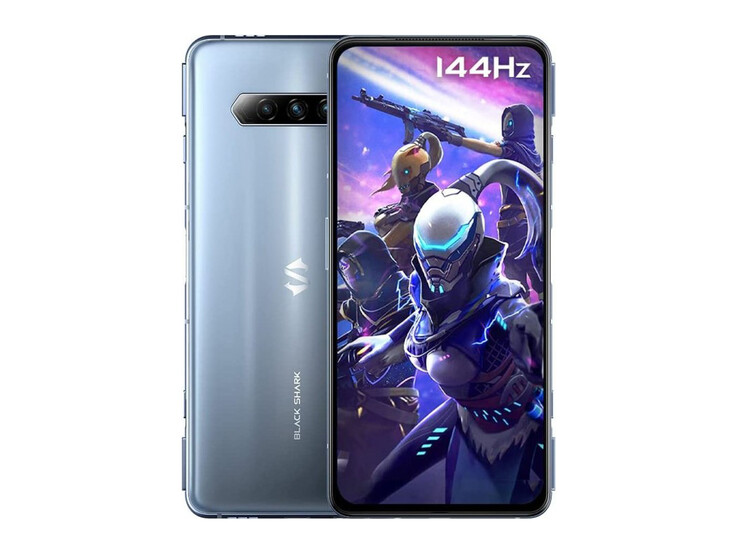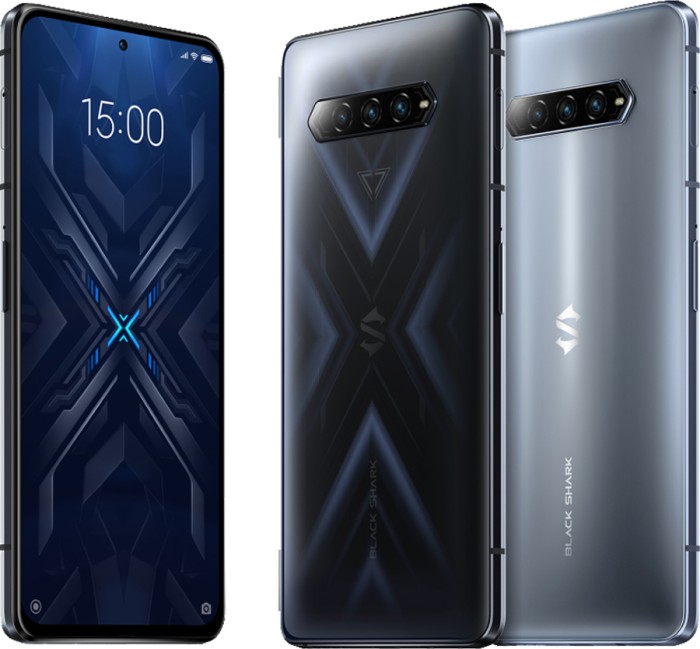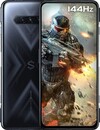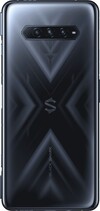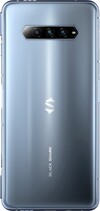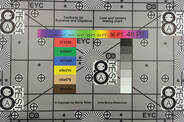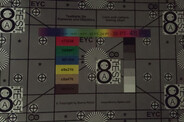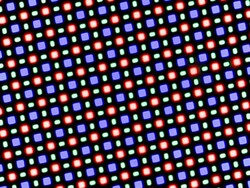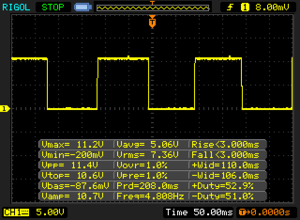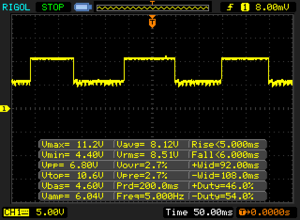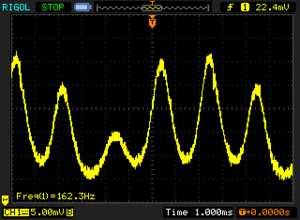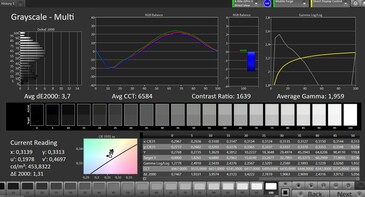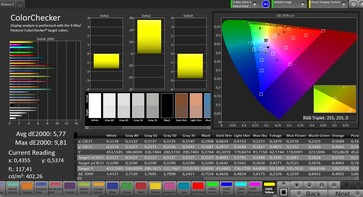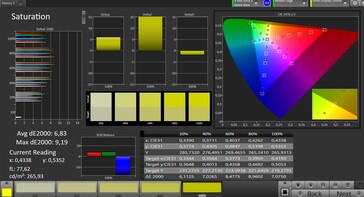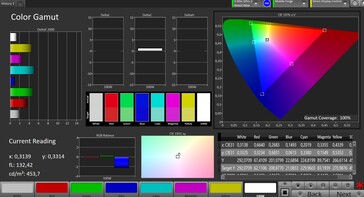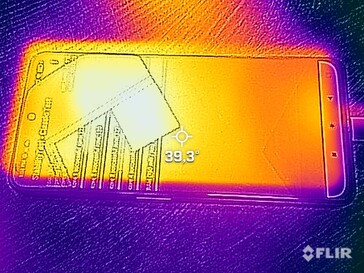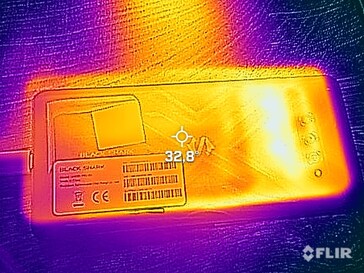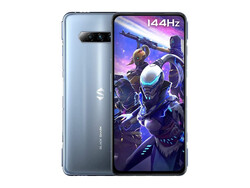Xiaomi Black Shark 4 smartphone review - Mobile gaming with 144 Hz display
Possible competitors in comparison
Rating | Rating Version | Date | Model | Weight | Drive | Size | Resolution | Price from |
|---|---|---|---|---|---|---|---|---|
| 86.3 % v7 (old) | v7 (old) | 07 / 2021 | Xiaomi Black Shark 4 SD 870, Adreno 650 | 210 g | 128 GB UFS 3.1 Flash | 6.67" | 2400x1080 | |
| 85.3 % v7 (old) | v7 (old) | 07 / 2020 | Xiaomi Black Shark 3 SD 865, Adreno 650 | 222 g | 128 GB UFS 3.0 Flash | 6.67" | 2400x1080 | |
| 88 % v7 (old) | v7 (old) | 04 / 2021 | Asus ROG Phone 5 SD 888 5G, Adreno 660 | 239 g | 256 GB UFS 3.1 Flash | 6.78" | 2448x1080 | |
| 87.7 % v7 (old) | v7 (old) | 04 / 2021 | Lenovo Legion Phone Duel 2 SD 888 5G, Adreno 660 | 259 g | 512 GB UFS 3.1 Flash | 6.92" | 2460x1080 |
Case, equipment and operation - Restrained gaming design
Several versions of the Xiaomi Black Shark 4 are available for purchase on the Internet:
- 6 GB RAM / 128 GB data storage starting at 429 Euros (~$507)
- 8 GB RAM / 128 GB data storage from 489 Euro (~$578)
- 12 GB RAM / 256 GB data storage from 579 Euro (~$684)
In addition, there is also a Black Shark 4 Pro with a Snapdragon 888, but it is hardly available in Central Europe.
The casing is available in two colors, but only Mirror Black is really available or affordable in Central Europe. The smartphone offers a relatively restrained design, if you compare, for example, the Lenovo Legion Phone Duel 2 as a comparison. Nevertheless, there are some special features: The surface on the back refracts the light so that it is reflected in the shape of an "X". The camera module sits in a hexagonal bezel. At 210 grams (~7.4 oz), the Black Shark 4 is pleasingly light for a gaming phone.
However, you have to do without LED effects. Instead, there are two mechanical triggers that are extended via sliders on the right cross side. When the device is turned on, a sound is heard when the triggers are activated for the first time, as if you were reloading a pistol. Whether you find this martial or cool is up to you.
In terms of Wi-Fi, the Black Shark 4 is on a good level and is on par with other gaming phones thanks to Wi-Fi 6 support. Of course, 5G reception is supported.
The software Android 11 is preinstalled, and Xiaomi adds its own gaming interface JoyUI on top. Games and special settings for gamers can be managed in the so-called Shark Space.
| Networking | |
| iperf3 transmit AX12 | |
| Asus ROG Phone 5 | |
| Xiaomi Black Shark 3 | |
| Lenovo Legion Phone Duel 2 | |
| Xiaomi Black Shark 4 | |
| iperf3 receive AX12 | |
| Xiaomi Black Shark 4 | |
| Lenovo Legion Phone Duel 2 | |
| Asus ROG Phone 5 | |
| Xiaomi Black Shark 3 | |
Cameras - Wide-angle camera on board
Three camera lenses are found on the back, although only two can be used for actual pictures: A 48-megapixel main camera, as well as an 8-megapixel wide-angle lens. There is also the 5-megapixel depth-of-field camera, which is only for support.
48-megapixel pictures can be recorded with the main camera, but only in a special mode. Usually, 12-megapixel images are created, which means 4 pixels are combined into one to increase the light yield. The camera takes decent pictures in normal lighting conditions, but the details could often be a bit more accurate. The wide-angle lens is also decent in its shots at first glance, but details are often no longer visible when looking closely.
The smartphone does well in low light and high contrasts. However, the image becomes a bit pixelated in only one lux of brightness, but colors and the image content can still be recognized in general.
The main camera can also record videos in 4K and with 60 fps if desired. The picture quality is good here as well. Exposure changes are quite fast and without large visible gradations, and the autofocus usually works reliably.
Image comparison
Choose a scene and navigate within the first image. One click changes the position on touchscreens. One click on the zoomed-in image opens the original in a new window. The first image shows the scaled photograph of the test device.
Main camera flowerMain camera environmentMain camera Low LightWide angle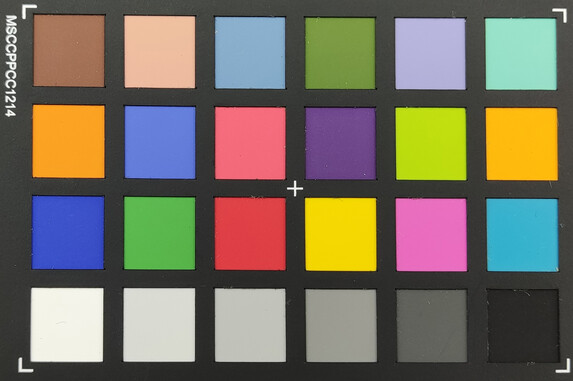
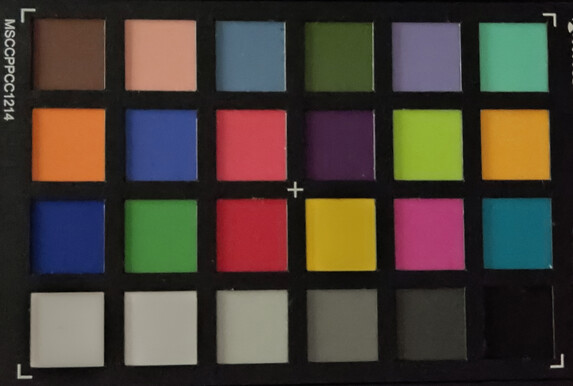
Display - 144 Hz AMOLED in the Black Shark 4
A fairly bright AMOLED screen with 1080p resolution is installed in Xiaomi's gaming phone. The even brightness distribution on the screen is good, but the color accuracy is rather mediocre. Thus, users who are looking for a display for professional applications will have to recalibrate the display with suitable software or look elsewhere.
Of course, the refresh rate is especially important for gamers: It has a maximum of 144 Hz. However, this cannot be used in all mobile games by any means. We tested it with PUBG Mobile and only achieved a maximum of 60 Hz, although at least 90 Hz would definitely be possible. Not only the game designer is responsible here, the phone manufacturer has to adjust certain things as well. However, high frame rates are often avoided by the manufacturers with the reference to high battery usage.
A quite strong OLED flickering is visible at brightness levels below 100%, but this is also common for this screen type. Before buying, you should try out whether you feel disturbed by it at low brightness.
| |||||||||||||||||||||||||
Brightness Distribution: 98 %
Center on Battery: 676 cd/m²
Contrast: ∞:1 (Black: 0 cd/m²)
ΔE ColorChecker Calman: 5.77 | ∀{0.5-29.43 Ø4.78}
ΔE Greyscale Calman: 3.7 | ∀{0.09-98 Ø5}
100% sRGB (Calman 2D)
Gamma: 1.959
CCT: 6584 K
| Xiaomi Black Shark 4 Super AMOLED, 2400x1080, 6.7" | Xiaomi Black Shark 3 AMOLED, 2400x1080, 6.7" | Asus ROG Phone 5 AMOLED, 2448x1080, 6.8" | Lenovo Legion Phone Duel 2 AMOLED, 2460x1080, 6.9" | |
|---|---|---|---|---|
| Response Times | -8% | 69% | 14% | |
| Response Time Grey 50% / Grey 80% * (ms) | 11 ? | 9 ? 18% | 2.4 ? 78% | 8 ? 27% |
| Response Time Black / White * (ms) | 6 ? | 8 ? -33% | 2.4 ? 60% | 6 ? -0% |
| PWM Frequency (Hz) | 162.3 | 227.3 | 568 ? | 568 |
| Screen | 14% | 39% | 1% | |
| Brightness middle (cd/m²) | 676 | 619 -8% | 789 17% | 463 -32% |
| Brightness (cd/m²) | 669 | 616 -8% | 795 19% | 466 -30% |
| Brightness Distribution (%) | 98 | 90 -8% | 98 0% | 98 0% |
| Black Level * (cd/m²) | ||||
| Colorchecker dE 2000 * | 5.77 | 3.74 35% | 1.4 76% | 3.24 44% |
| Colorchecker dE 2000 max. * | 9.81 | 7.94 19% | 3 69% | 5.75 41% |
| Greyscale dE 2000 * | 3.7 | 1.7 54% | 1.7 54% | 4.4 -19% |
| Gamma | 1.959 112% | 2.188 101% | 2.27 97% | 2.201 100% |
| CCT | 6584 99% | 6662 98% | 6596 99% | 7273 89% |
| Total Average (Program / Settings) | 3% /
9% | 54% /
47% | 8% /
4% |
* ... smaller is better
Display Response Times
| ↔ Response Time Black to White | ||
|---|---|---|
| 6 ms ... rise ↗ and fall ↘ combined | ↗ 3 ms rise | |
| ↘ 3 ms fall | ||
| The screen shows very fast response rates in our tests and should be very well suited for fast-paced gaming. In comparison, all tested devices range from 0.1 (minimum) to 240 (maximum) ms. » 17 % of all devices are better. This means that the measured response time is better than the average of all tested devices (20.2 ms). | ||
| ↔ Response Time 50% Grey to 80% Grey | ||
| 11 ms ... rise ↗ and fall ↘ combined | ↗ 5 ms rise | |
| ↘ 6 ms fall | ||
| The screen shows good response rates in our tests, but may be too slow for competitive gamers. In comparison, all tested devices range from 0.165 (minimum) to 636 (maximum) ms. » 23 % of all devices are better. This means that the measured response time is better than the average of all tested devices (31.6 ms). | ||
Screen Flickering / PWM (Pulse-Width Modulation)
| Screen flickering / PWM detected | 162.3 Hz | ||
The display backlight flickers at 162.3 Hz (worst case, e.g., utilizing PWM) . The frequency of 162.3 Hz is relatively low, so sensitive users will likely notice flickering and experience eyestrain at the stated brightness setting and below. In comparison: 53 % of all tested devices do not use PWM to dim the display. If PWM was detected, an average of 8108 (minimum: 5 - maximum: 343500) Hz was measured. | |||
Performance, emissions and battery life - Fast, but not top class
In terms of performance, the Snapdragon 870 is used as the SoC, so it is not the absolute top league in terms of performance, but it is still a powerful processor. Thus, the review sample is superior to its predecessor Black Shark 3 by about 10% in some areas in terms of performance. You should hardly notice the difference in practice. The graphics performance is also slightly higher, and a few additional frames in games are certainly welcome.
The memory is quite fast thanks to the UFS 3.1 memory and proves to be reliable and fast in our benchmarks.
Warming is on the usual level for high-performance smartphones and should hardly cause any problems under everyday conditions.
The stereo speakers clearly show more low mids and even a bit of bass in our measurements. The smartphone stands out with good sound in everyday use, which is not completely convincing, but still sounds better than many other smartphones in this price range.
The battery runtimes have to be limited a bit: At 4,500 mAh the battery is slightly smaller than in other smartphones in the price range; 5,000 mAh are now standard. Thus, the device achieves 11:50 hours in our WLAN test. That is a good result, but you can still get more elsewhere. The smartphone can be charged with up to 120 watts. The available charger does not provide this power, but only 67 watts and manages to recharge the device in just over an hour. You already have enough power for a few hours of use after a few minutes.
| Xiaomi Black Shark 4 | Xiaomi Black Shark 3 | Asus ROG Phone 5 | Lenovo Legion Phone Duel 2 | Average 128 GB UFS 3.1 Flash | Average of class Smartphone | |
|---|---|---|---|---|---|---|
| AndroBench 3-5 | -9% | 6% | 3% | -7% | 53% | |
| Sequential Read 256KB (MB/s) | 1663 | 1692 2% | 1779 7% | 1999 20% | 1569 ? -6% | 2227 ? 34% |
| Sequential Write 256KB (MB/s) | 760 | 680 -11% | 795 5% | 754 -1% | 768 ? 1% | 1848 ? 143% |
| Random Read 4KB (MB/s) | 283.1 | 238.3 -16% | 291.4 3% | 262.6 -7% | 244 ? -14% | 295 ? 4% |
| Random Write 4KB (MB/s) | 259.9 | 227.8 -12% | 278 7% | 261.5 1% | 243 ? -7% | 334 ? 29% |
Temperature
(±) The maximum temperature on the upper side is 42 °C / 108 F, compared to the average of 35.2 °C / 95 F, ranging from 21.9 to 247 °C for the class Smartphone.
(±) The bottom heats up to a maximum of 41.8 °C / 107 F, compared to the average of 34 °C / 93 F
(+) In idle usage, the average temperature for the upper side is 27.9 °C / 82 F, compared to the device average of 32.9 °C / 91 F.
Speaker
Xiaomi Black Shark 4 audio analysis
(+) | speakers can play relatively loud (82 dB)
Bass 100 - 315 Hz
(-) | nearly no bass - on average 18.7% lower than median
(±) | linearity of bass is average (10.4% delta to prev. frequency)
Mids 400 - 2000 Hz
(±) | higher mids - on average 5.4% higher than median
(±) | linearity of mids is average (7.1% delta to prev. frequency)
Highs 2 - 16 kHz
(+) | balanced highs - only 3.6% away from median
(+) | highs are linear (5.3% delta to prev. frequency)
Overall 100 - 16.000 Hz
(±) | linearity of overall sound is average (19.5% difference to median)
Compared to same class
» 28% of all tested devices in this class were better, 8% similar, 64% worse
» The best had a delta of 11%, average was 35%, worst was 134%
Compared to all devices tested
» 48% of all tested devices were better, 7% similar, 45% worse
» The best had a delta of 4%, average was 24%, worst was 134%
Xiaomi Black Shark 3 audio analysis
(±) | speaker loudness is average but good (80.8 dB)
Bass 100 - 315 Hz
(-) | nearly no bass - on average 63.8% lower than median
(+) | bass is linear (0% delta to prev. frequency)
Mids 400 - 2000 Hz
(-) | nearly no mids - on average 63.8% lower than median
(+) | mids are linear (0% delta to prev. frequency)
Highs 2 - 16 kHz
(-) | nearly no highs - on average 63.8% lower than median
(+) | highs are linear (0% delta to prev. frequency)
Overall 100 - 16.000 Hz
(-) | overall sound is not linear (121% difference to median)
Compared to same class
» 90% of all tested devices in this class were better, 8% similar, 2% worse
» The best had a delta of 11%, average was 35%, worst was 134%
Compared to all devices tested
» 97% of all tested devices were better, 2% similar, 1% worse
» The best had a delta of 4%, average was 24%, worst was 134%
Battery life
| Xiaomi Black Shark 4 4500 mAh | Xiaomi Black Shark 3 4720 mAh | Asus ROG Phone 5 6000 mAh | Lenovo Legion Phone Duel 2 5500 mAh | Average of class Smartphone | |
|---|---|---|---|---|---|
| Battery Runtime | |||||
| WiFi Websurfing (h) | 11.8 | 11.7 -1% | 12.6 7% | 15.1 28% | 19.3 ? 64% |
Pros
Cons
Verdict - Good gaming phone with NFC
The Xiaomi Black Shark 4 is again a solid gaming phone and also has a goodie up its sleeve with mechanical triggers: The buttons work more reliably than in other gaming smartphones with touch solutions. The phone's design is comparatively restrained and doesn't offer LED lighting effects like other gaming phones.
The camera delivers good pictures, the speakers can even convey a bit of bass feeling and the smartphone is relatively light. The battery runtimes could be longer, but it is sufficient for everyday use.
Finally, you also get NFC, but you still have to do without wireless charging and IP certification.
Xiaomi has successfully developed its gaming smartphone further with the Black Shark 4 and delivers a good gamer phone in a comparatively discreet design.
Overall, the Black Shark 4 is a successful evolution compared to the predecessor. It is a good gaming phone for those who want to save money, but if you really want the highest gaming power currently available, you should, for example, go for the Asus ROG Phone 5 or the Lenovo Legion Phone Duel 2.
Price and availability
The gaming smartphone is available from $679.99 at Amazon with 12 GB RAM / 256 GB mass storage. The versions with more storage are also available there. On the website of Black Shark you can currently only get the version with 12 GB / 256 GB for €599 (~$708).
Xiaomi Black Shark 4
- 08/31/2022 v7 (old)
Florian Schmitt




